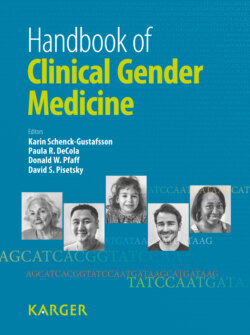Читать книгу Handbook of Clinical Gender Medicine - Группа авторов - Страница 34
На сайте Литреса книга снята с продажи.
Social Implications
ОглавлениеThe consequences of medically-abetted mass feticide are far reaching and manifestly adverse. In populations with unnaturally skewed SRBs, the very fact that many thousands - or in some cases, millions - of prospective girls and young women have been deliberately eliminated simply because they would have been female establishes a new social reality that inescapably colors the whole realm of human relationships, redefining the role of women as the disfavored sex in nakedly utilitarian terms and indeed signaling that their very existence is now conditional and contingent.
Moreover, enduring and extreme SRB imbalances set the demographic stage for an incipient ‘marriage squeeze’ in affected populations, especially where subreplacement is reducing the future pool of potential brides. China’s persistently elevated SRBs, for example, stand to transform it from a country where as of 2000 nearly all males (about 96%) had been married by their early 40s to one in which nearly a quarter (23%) are projected to be never married as of 2040, less than 30 years from now.5 Such a transformation augurs ill in a number of respects. For one thing, unmarried men appear to suffer greater health risks than their married counterparts, even after controlling for exogenous social and environmental factors;6 a sharp increase in the proportion of essentially unmarriageable males in a society with a universal marriage norm may only accentuate those health risks. In a low-income society lacking sturdy and reliable national pension guarantees for the elderly, a steep rise in the proportion of unmarried and involuntarily childless men begs the question of old-age support for that rising cohort. Some economists have hypothesized that mass feticide, in making women scarce, will only increase their ‘value’ [40] - but in settings where the legal and personal rights of the individual are not secure and inviolable, the ‘rising value of women’ can have perverse and unexpected consequences, including increased demand for prostitution and an upsurge in the kidnapping and trafficking of women. This phenomenon is now reportedly being witnessed in some women-scarce areas in Asia [41].
Finally, there is the speculative question of the social impact of a sudden addition of a large cohort of young ‘excess males’ to populations sustaining extreme SRBs: depending on a given country’s cultural and institutional capabilities for coping with this challenge, such trends could quite conceivably lead to increased crime, violence, and social tensions - or possibly even a greater proclivity for social instability.7
All in all, mass sex selection can be regarded as a ‘tragedy of the commons’ dynamic, in which the aggregation of individual (parental) choices has the inadvertent result of degrading the quality of life for all - and some much more than others.
What are the prospects for mass sex-selective feticide in the years immediately ahead? Unfortunately, there is ample room for cautious pessimism. Although biologically unnatural SRBs now characterize an expanse accounting for something approaching half of humanity, it is by no means clear that this march has yet ceased.
As we have seen, sudden steep increases in SRBs are by no means inconsistent with continuing improvements in levels of per capita income and female education - or for that matter, with legal strictures against sex-selective abortion. Two of the key factors associated with unnatural upsurges in nationwide SRBs - low or subreplacement fertility levels and easy access to inexpensive prenatal gender determination technology - will likely be present in an increasing number of low-income societies in the years and decades immediately ahead. The third factor critical to mass female feticide - son preference - is perhaps surprisingly difficult to identify in advance. In theory, the overbearing son preference should be available from demographic and health surveys (DHS) - such as India’s National Family and Health Survey, which demonstrated that prospective mothers in the state of Punjab desired their next child to be male rather than female by a ratio of 10 to 1.8 However, ironically, despite the many tens of millions of dollars that international aid and development agencies have spent on the hundreds of DHS surveys they have supported in low-income countries over recent decades, information on sex preference to date is almost never collected. Differential infant and child mortality rates arguably offer clues about son preference. Societies where female mortality rates exceed male rates may be correspondingly disposed to prenatal gender discrimination as well. According to WHO 2008 Life Tables, over 60 countries currently experience higher infant or 1-4 mortality rates for girls than for boys. The roster includes much of South-Central Asia (Afghanistan, Bangladesh, Nepal, Pakistan, Turkmenistan, and Uzbekistan), North Africa and the Middle East (Bahrain, Egypt, Morocco, Jordan, Oman, and Yemen), parts of Latin America and the Caribbean (Bolivia, Ecuador, Haiti, Honduras, Nicaragua, and Trinidad and Tobago), and over a dozen countries in sub-Saharan Africa, including the sub-Saharan demographic giants of Nigeria, Ethiopia, and Sudan [44]. If such gender bias in mortality turns out to be a predictor of sex selection bias, this global problem may get considerably worse before it gets better.
